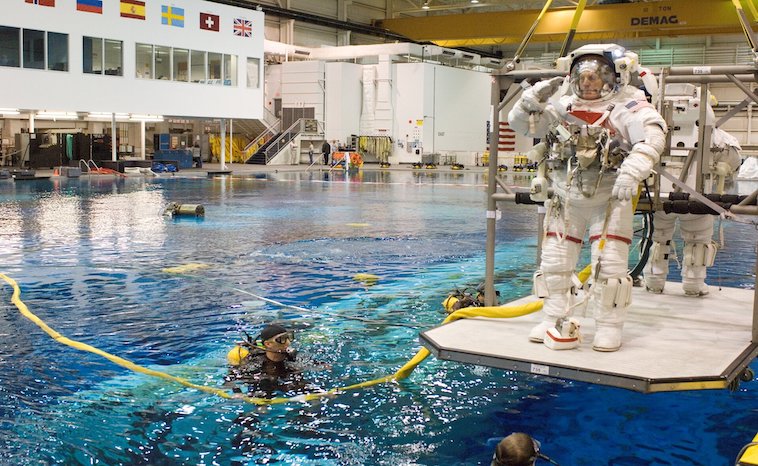Neutral Buoyancy Laboratory Trains Astronauts

What is one the best ways for an astronaut to train for space? Read on to find out about NASA’s neutral buoyancy laboratory.
Astronauts train for spacewalks in a variety of ways. A critical part of their training takes place at NASA’s Neutral Buoyancy Laboratory. Located on the grounds of NASA’s Johnson Space Center, the indoor pool contains a replica of the International Space Station and other modules. The laboratory also allows businesses to rent time to practice using underwater Remote Operating Vehicles (ROV).
Neutral Buoyancy Laboratory
The Neutral Buoyancy Laboratory (NBL) came into existence from an earlier version of the pool. The Weightless Environmental Training Facility operated from 1980 through 1998. The dimensions of the pool were 24 meters (78 ft) by 10 meters (33 ft), with a depth of 7.6 meters (25 ft). NASA purchased the facility from McDonnell Douglas in the early 1990s. The NBL began operation in 1997. Its new dimensions are astounding. The pool’s dimensions are 62 meters (202 ft) by 31 meters (102 ft), with a depth of 12 meters (40 ft). It holds 6.2 million gallons (23.5 million liters) of water.
Water Training for Space
Trainees wear suits designed to provide neutral buoyancy. Neutral buoyancy occurs when an object’s average density is equal to the density of the fluid in which it is immersed. If someone’s body is denser the density of the fluid, than they will sink. However, if someone is less dense than the fluid, they will float. An object that has neutral buoyancy will neither sink nor rise. The pool helps to simulate the microgravity that astronauts would experience during spaceflight.
To achieve neutral buoyancy, suited astronauts or pieces of equipment are lowered into the pool using an overhead crane. They are then weighted in the water by support divers so that they experience minimal buoyant force. The buoyant force is an upward force exerted by a fluid that opposes the weight of a partially or fully immersed object. Furthermore, the weights help provide minimal rotational moments about their center of mass.

Physical Issues
One downside of neutral buoyancy simulation is that astronauts are not weightless within their suits. This means that as divers tilt their suits, they are pressed against whatever inside surface is facing down. Astronaut Peggy Whitson suffered problems during her underwater training. She attributes the issue to the suit, which, even in the smallest size available—a medium—was too big for her. Technicians added padding, but she says she still found herself flopping around inside of it. The effort to stabilize herself led to overuse in her elbows, including torn tendons and muscles. As a result, Whitson says she can’t straighten her arms all the way because of her training in the pool. Thus, precise suit sizing is critical.
Objects in the Water
The NBL contains full-scale mock-ups of International Space Station (ISS) modules and payloads. Furthermore, it has vehicles such as the Japan Aerospace Exploration Agency (JAXA) HTV, the European Space Agency ATV, and the SpaceX Dragon. Mission Control follows the movements of the submerged astronauts, in real-time footage captured by divers with cameras. The astronauts travel glove over glove over the station, using neutrally buoyant versions of tools to conduct tasks that mimic the real work as much as possible. They also practice emergency drills, such as rescuing an incapacitated spacewalking partner.
